25 Micrograms Of Vitamin D Is How Many Iu

By: Dr. Alan Christianson
By now you've heard your body needs vitamin D to be at its best. Feel free to read HERE to learn more about its many benefits, like lowering risks of:
- Mortality (death)
- Cancer
- Heart disease
- Dementia
- Asthma
- Infections
- Obesity
There has been plenty of focus on the dangers of getting too little vitamin D, but did you know you can also get too much?
By getting "too much", I don't mean a toxic overdose. That is possible, but it's pretty unlikely. Most people would need over 50,000 IU per day for four or more weeks to reach toxic blood levels of over 150 ng/ml.
The concern about getting too much is there seems to be a sweet spot where vitamin D helps the most. If you're slightly above this sweet spot, vitamin D is not dangerous, but is less helpful.
Blood Levels
So, what is the best blood level of vitamin D? Here is what some experts and public figures say:
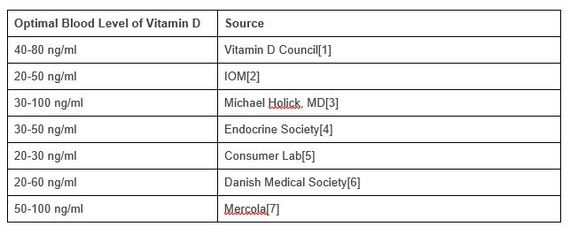
Wow, this is quite a range! I wish these recommendations lined up, but they don't. Let's say you want to think of 30 as the bottom of the best range. Well, the Vitamin D Council says you're getting too little. If you say 40, then Consumer Lab says you're getting too much. What's the upper limit? You can see how there is no amount that will satisfy everyone.
Let's start with something easy: How little is not enough?
Vitamin D deficiency =
Everyone agrees it's bad to be below 20 ng/ml. At this range, vitamin D is inadequate for bone health and disease risk in general. Past this, we have to start thinking it through and looking at studies.
Types of Vitamin D Studies
The majority of studies used in determining ideal vitamin D levels have looked at people who already have a disease and checked their vitamin D status. These are called, "case control studies". A smaller number of studies have monitored those with a disease and followed how well they did over time compared to their vitamin D status. These are called, "cohort studies".
Studies generally look for a relationship between vitamin D and some facet of health. A difficulty is it's possible to see one facet of health get better while another gets worse. An example would be the medications that lower cholesterol, yet don't lower the risk of heart attacks.
Mortality Cohort Studies
Because of these concerns, some of the most meaningful studies are those that categorize people based on their vitamin D levels, and watch how long they live.
J-Shaped Curves
Most mortality studies on vitamin D show that both too little and too much is bad. Researchers call this a "J-shaped curve".
Where does the "J" come from? In the image below, the orange line is the J shape. As it shows people too lean on the left of the scale, more die. On the right side, as people get too heavy, more also die.
Note these exact numbers are for illustrative purposes only.
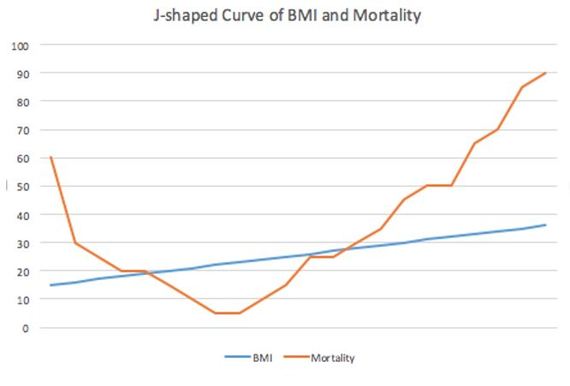
You want to be in the bottom of the J-shaped curve--that's the sweet spot with the least risk of death.
Nutrients and hormones are normally found in the human body. When we compare how they work in the body with how much we have, a common trend emerges. When the substance is too low, something doesn't work. As the levels improve, the function gets better, to a point. As the levels get higher, it eventually becomes too much, and things start to get worse again.
We see the same thing for nearly all nutrients studied. If you have too little iodine, your thyroid can slow down. Too much iodine can also slow your thyroid. If you have no vitamin C, you can get a disease, called scurvy. If you take a mega dose of vitamin C and then reduce it, you can get rebound scurvy. Too much testosterone can give a man feminization symptoms, like breast growth. Too little vitamin B6 can cause nerve damage. Guess what overdosing on B6 does? Yes, it causes nerve damage.
What is the sweet spot for Vitamin D and longevity?
The largest single study to date focused on cardiovascular deaths, primarily heart attack and stroke. In it, 247,574 people were monitored for seven years. The population was tracked for vitamin D levels, and these were compared to cardiovascular death.
Results showed death risks were highest for both those lowest and those highest in vitamin D. The lowest risk of death was found in those with vitamin D levels of 30-49 ng/ml, based on the author's conclusions.[8]
A large review of several other studies on vitamin D and mortality came to similar conclusions. In it, researchers combined studies, totaling 62,548 people, who were studied for death risk and vitamin D levels. The image below summarizes these studies.
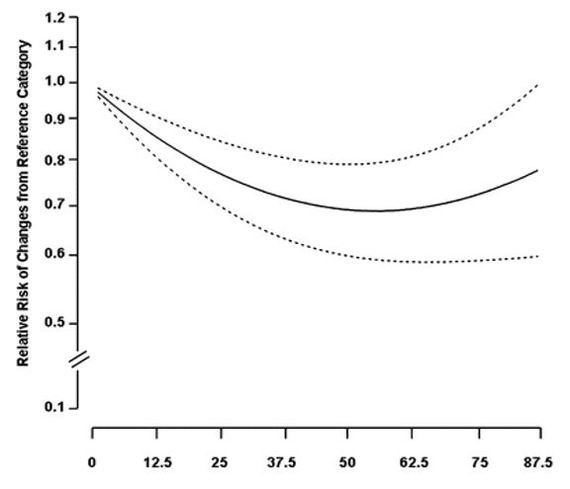
The researchers concluded that those whose vitamin D levels were in the 30-50 ng/ml range had the lowest risk of death.[9]
Another study of all-cause mortality among 13,331 Americans, tracked for 12 years, showed similar results.[10]
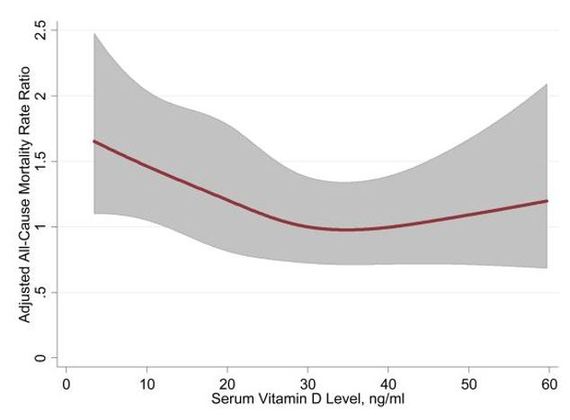
A final study of 15,099 American adults, tracked for over 18 years, revealed the same thing: Those with vitamin D in the range of 30-49 ng/ml had the lowest rate of total mortality.[11]
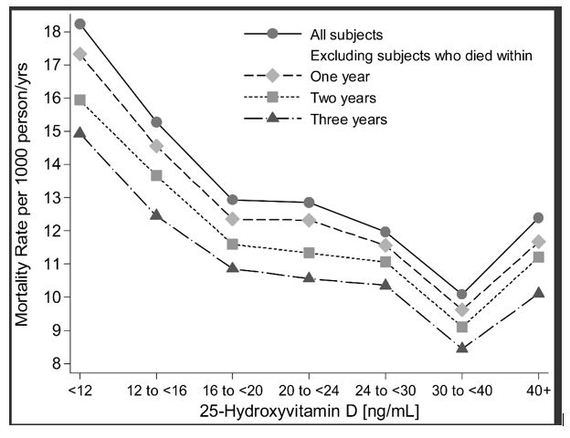
What is the sweet spot for vitamin D and longevity? All studies are in agreement: 30-50 ng/ml.
How can you get the right amounts of vitamin D? Let's discuss the main sources.
Sources of vitamin D
We get vitamin D from supplements, sun and food--and in that order for most of us.
Food
Considering a need in units of thousands of IU's per day, food doesn't have much. Some of the highest sources have only a few hundred units.
Food sources of Vitamin D:[12]
- Salmon: 4 oz. = 500 IU
- Sardines: 3.2 oz. = 175 IU
- Cow's milk: 1/2 cup (fortified, 2% or greater fat) = 62 IU
- Eggs: 1 = 143 IU
- Shiitake mushrooms: 1/2 cup = 20 IU
Sun
I find getting your vitamin D from the sun both intriguing and appealing. If you find yourself so motivated to be exacting about your duration of exposure per season, please read The Vitamin D Solution, by Dr. Michael Holick. He has a great section, containing the Holick Sun Tables, to help you figure this out.
Overall, the sun can work, yet I find it inconsistent. Despite the fact I practice in one of the sunniest parts of the world, nearly all my patients, who are not taking vitamin D supplements, are vitamin D deficient. I'm also concerned about squamous and basal cell cancers, as well as skin aging from sun exposure.
Supplements
Given all that, it's really comes down to supplements. Supplements have the advantage of safely providing a consistent dose, which is easy to adjust as needed.
So, how much should you take?
Many sources, including our government, are happy to give exact guidelines like these:[13]

Why not just take the recommended dose, and call it "good"?
Two reasons:
These dosages fail to account for the fact not all people achieve the same blood level on the same dosage.
These dosages are only recommended to reach a high enough blood level to prevent a deficiency, not to achieve an optimal level.
Blood Level vs. Dosage
Not everyone who takes the same dose of vitamin D ends up with the same blood levels.
When you compare dosages to blood levels in large numbers of people, results vary. Some people need much higher or much lower doses than others to achieve the same blood levels.
One issue is weight. Body fat pulls vitamin D out of the blood stream, and makes it inactive. The more fat you have, the more vitamin D you'll need to take to have enough in your blood.
The chart below shows how blood levels of vitamin D elevated several hours after people took a single oral dose of 50,000 IU. The top line was the response in lean people; the lower line was the response in the obese.[14]
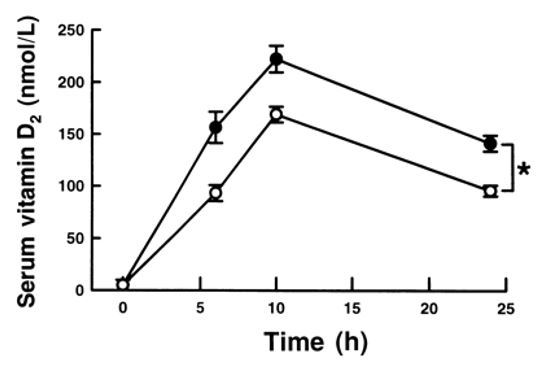
Even apart from body weight, people can have significant individual variation in how they absorb vitamin D.
The chart below shows, in one extreme, there are individuals who require as high as 20,000 units to reach sufficient blood levels. On the opposite extreme, others have high blood levels with as little as a few hundred units per day.[15]
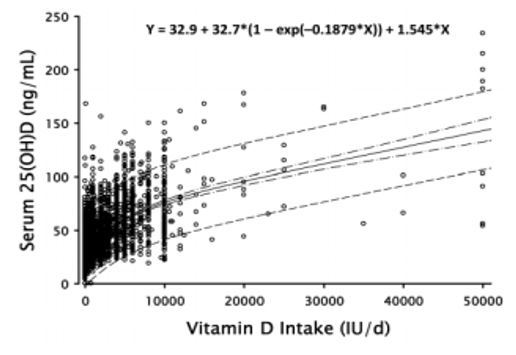
Get Tested
Thankfully, this problem is pretty easy to work around. Just take the same amount of vitamin D each day from supplements, and test your levels. I suggest testing every three months until you get to target and then, every six months thereafter.
You can do either a normal blood draw or a blood spot test at home. (These accurate home tests can be done by yourself and mailed into a lab.)
The preferred test is called, "25-hydroxy vitamin D" or "25 OH-Vitamin D".
Which Units?
When testing Vitamin D and looking at research, please note you'll find reports in two different units: ng/ml and nmol/L. They are not the same and can create a ton of confusion!
Most blood tests report your results in ng/ml. Most research studies use nmol/L. The conversion is to multiply ng/ml x 2.5 to get nmol/L.[16]

How Much to Take
If your blood levels are low, how much vitamin D should you take? Here is how a dosage affects blood levels on average: [17]
- 100 IU (2.5 mcg) per day increases vitamin D blood levels 1 ng/ml (2.5 nmol/L).
- 500 IU (12.5 mcg) per day increases vitamin D blood levels 5 ng/ml (12.5 nmol/L).
- 1000 IU (25 mcg) per day increases vitamin D blood levels 10 ng/ml (25 nmol/L).
- 2000 IU (50 mcg) per day increases vitamin D blood levels 20 ng/ml (50 nmol/L).
Please think of these as starting points. Adjust your dose, and keep testing and making small adjustments until you get it right.
How to Take Vitamin D
Should you take vitamin D with food? With fat?
The largest review study to date concluded that whether you have it with food or not, or with fat or not, it doesn't matter.
"...the amount of fat with which vitamin D is ingested does not seem to significantly modify the bioavailability of vitamin D3, [and] the food matrix has apparently little effect on vitamin D bioavailability..."[18]
Should you take vitamin D liquid or capsules?
I recommend capsules over liquid. It seems intuitive that liquid would be better absorbed, but the study above saw no differences. Furthermore, it can be hard to get a consistent dose with liquids. Drops are not always the same size nor easy to count. There have been case reports of people unintentionally overdosing by getting too many drops.
How often should you take vitamin D?
Since it is fat-soluble, either once or twice daily works well. I don't recommend once-weekly or once-monthly dosing because many patients have anecdotally shared with me they feel fatigued the first 1-2 days after a high dose.
_________________________________________________________
[1] Vitamin D Council, "I tested my vitamin D level. What do my results mean?," July 30, 2010, http://www.vitamindcouncil.org/further-topics/i-tested-my-vitamin-d-level-what-do-my-results-mean/.
[2] National Institutes of Health: Office of Dietary Supplements, "Vitamin D," February 11, 2016, https://ods.od.nih.gov/factsheets/VitaminD-HealthProfessional/.
[3] Michael Holick, MD, The Vitamin D Solution: A 3-Step Strategy To Cure Our Most Common Health Problems, (New York: Penguin, 2011), 148.
[4] Holick MF, et al., "Evaluation, Treatment, and Prevention of Vitamin D Deficiency: An Endocrine Society Clinical Practice Guideline," Journal of Clinical Endocrinology & Metabolism, July 2011, 96(7): 1911-1930.
[5] "Does Your Vitamin D Supplement Contain What's on the Label? Not All Do!," Consumer Lab, last modified April 20, 2016 (paid content). https://www.consumerlab.com/reviews/vitamin_D_supplements_review/Vitamin_D/
[6] Skaaby, T, "The relationship of vitamin D status to risk of cardiovascular disease and mortality," Danish Medical Journal, 2015;62(2):B5008.
[7] Mercola, J, "New Analysis Claims Vitamin D Supplements Are Useless - Here's Why It's Wrong," February 17, 2014, http://articles.mercola.com/sites/articles/archive/2014/02/17/vitamin-d-supplements.aspx
[8] Durup D, et al., "A Reversed J-Shaped Association Between Serum 25-Hydroxvitamin D and Cardiovascular Disease Mortality: The CopD Study," The Journal of Clinical Endocrinology and Metabolism, 2015 Jun;100(6):2339-46. doi: 10.1210/jc.2014-4551, Epub 2015 Feb 24.
[9] Zitterman, A, et al., "Vitamin D deficiency and mortality risk in the general population: a meta-analysis of prospective cohort studies 1,2,3,4," The American Journal of Clinical Nutrition, January 2012
vol. 95 no. 1 91-100, first published December 14, 2011, doi: 10.3945/ajcn.111.014779
[10] Melamed, ML, et al., "25 hydroxyl vitamin D levels and The Risk of Mortality in the General Population," Archives of Internal Medicine, 2008 Aug 11: 168(15): 1629-1637, doi: 10.1001/archinte. 168.15.1629.
[11] Kramer H, et al., "Mortality Rates Across 25-Hydroxyvitamin D (25[OH]D) Levels among Adults with and without Estimated Glomerular Filtration Rate [12] Jakobsen J, Knuthsen P, "Stability of vitamin D in foodstuffs during cooking," Food Chemistry, 2014;148:170-5, doi: 10.1016/j.foodchem.2013.10.043, Epub 2013 Oct 17.
[13] Institute of Medicine, Food and Nutrition Board. Dietary Reference Intakes for Calcium and Vitamin D. Washington, DC: National Academy Press, 2010
[14] Wortsman J, Matsuoka L, Chen T, et al., "Decreased bioavailability of vitamin D in obesity," American Journal of Clinical Nutrition, September 2000, vol. 72 no. 3 690-693.
[15] Heaney RP, et al., "25-Hydroxylation of vitamin D3: relation to circulating vitamin D3 under varying input conditions," American Journal of Clinical Nutrition, 87: 1730-1737, 2008.
[16] Kramer H, et al., "Mortality Rates Across 25-Hydroxyvitamin D (25[OH]D) Levels among Adults with and without Estimated Glomerular Filtration Rate [17] Cranney C, et al., "Effectiveness and safety of vitamin D," Evidence Report/Technology Assessment No. 158 prepared by the University of Ottawa Evidence-based Practice Center under Contract No. 290-02.0021. AHRQ Publication No. 07-E013. Rockville, MD: Agency for Healthcare Research and Quality, 2007.
[18] Borel P, Caillaud D, Cano NJ, "Vitamin D bioavailability: state of the art," Critical Reviews in Food Science and Nutrition, 2015;55(9):1193-205. doi: 10.1080/10408398.2012.688897.
25 Micrograms Of Vitamin D Is How Many Iu
Source: https://www.huffpost.com/entry/how-much-vitamin-d-should_b_9914288

Tidak ada komentar: